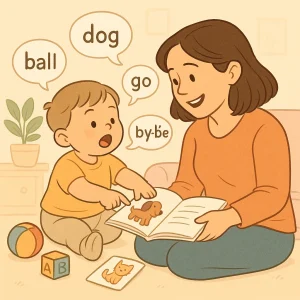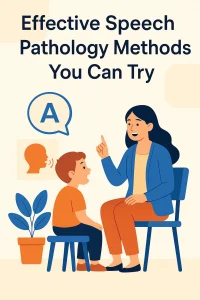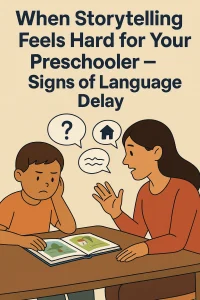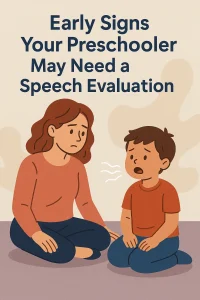Easy Speech Therapy Exercises at Home for Toddlers
By Wellness Hub
Last Updated: October 15, 2024
As a parent, you’re your child’s first and most important teacher, especially when it comes to speech development. Early intervention through speech therapy at home can make a world of difference for toddlers and preschoolers. With simple techniques and consistent practice, you can support your child’s journey to clearer communication. The benefits of home-based speech therapy exercises are immense, allowing for personalized attention, comfort, and flexibility. Discover how you can play a crucial role in boosting your child’s speech development from the comfort of your home—because every word counts!
Looking for expert-led speech support at home? Discover simple, effective exercises you can combine with online speech therapy for toddlers and preschoolers — guided by certified professionals.
Understanding Your Child’s Speech Milestones
Monitoring your child’s speech milestones is essential for ensuring healthy language development. Each child progresses at their own pace, but there are common speech milestones for toddlers and preschoolers that parents and caregivers should keep in mind.
1. Speech Milestones for Toddlers
By the age of 18 months, most toddlers can say around 10 to 20 words. By 24 months, they should be combining two words to form simple phrases like “more juice” or “mama go.” At this stage, toddlers typically follow simple instructions and can point to objects or body parts when named. If your child is not meeting these language development stages, it might be time to observe their communication closely.
2. Speech Milestones for Preschoolers
By the age of 3 to 4 years, preschoolers should be able to form sentences of three to four words and engage in simple conversations. Their vocabulary rapidly grows, reaching around 900 to 1,000 words by age 4. At this point, preschoolers should also be able to follow two-step directions, understand basic grammar rules, and use pronouns like “I” and “you.” Speech milestones for preschoolers include being understood by strangers about 75% of the time.
Also read: Speech Therapy at Home: Key Tips Every Parent Should Know
3. Signs Your Child May Need Speech Therapy at Home
It’s crucial to recognize when your child may need extra support. If your toddler isn’t saying any words by 18 months, or if your preschooler struggles with forming sentences by age 3, these could be signs of speech delays. Other signs that may indicate the need for speech therapy at home include:
- Limited vocabulary or difficulty learning new words
- Difficulty following instructions
- Trouble pronouncing common sounds like “p,” “b,” or “m”
- Frustration during communication or being difficult to understand by family members
Also Read: How Can Speech Therapy at Home Help Your Child’s Language?
Early intervention can make a huge difference. If you notice any of these signs, consider speaking to a speech therapist for guidance on how to support your child’s language development stages effectively.
Proven Speech Therapy Exercises for Toddlers
Speech therapy exercises for toddlers are essential to support speech development and address any early signs of speech delay. Below are some simple and proven toddler speech development activities designed to help improve articulation, vocabulary, and communication skills. These activities are fun, engaging, and easy to practice at home.
List of proven speech therapy exercises tailored for toddlers (ages 1-3)
| Exercise | Description | Benefits |
|---|---|---|
| Imitation Games | Encourage your toddler to imitate sounds, words, or simple phrases you say. | Helps with articulation, sound recognition, and speech fluency. |
| Animal Sound Imitation | Make animal sounds (like “moo” or “woof”) and encourage your toddler to mimic them. | Builds articulation and sound differentiation. |
| Repetitive Word Games | Use repetition by playing games with commonly used words (e.g., “ball,” “cat”). | Helps expand vocabulary and reinforce word usage. |
| Naming Everyday Objects | Point to objects around the house (like “cup” or “car”) and ask your toddler to name them. | Builds vocabulary and understanding of objects. |
| Picture Books Interaction | Read simple picture books and ask your toddler to name objects or animals. | Improves language comprehension and word association. |
| Sing Songs Together | Sing simple nursery rhymes or songs, emphasizing key words or sounds. | Enhances rhythm, rhyme awareness, and speech fluency. |
| Interactive Flashcards | Use flashcards with pictures and words, and encourage your child to say the word aloud. | Reinforces vocabulary and speech clarity. |
| Simple Choices | Give your toddler two choices (e.g., “apple or banana?”) and encourage them to respond. | Helps with decision-making and verbal expression. |
| Sound Exploration | Play with different sounds using objects like a drum, bell, or whistle, and ask your child to copy them. | Develops sound recognition and verbal imitation. |
These speech delay exercises are designed to fit naturally into your toddler’s daily routine. By incorporating these activities into playtime, parents and caregivers can make a significant impact on their child’s language development. Remember, consistency is key! Keep the exercises fun and engaging to encourage continued participation.
Effective Speech Therapy Exercises for Preschoolers
Below is a table of simple yet effective speech therapy exercises for preschoolers, focusing on language skills development for 3-5-year-olds. These activities promote interaction, fun, and learning through everyday play while targeting speech improvement.
Proven Speech Therapy Exercises Tailored for Preschoolers (Ages 3-5)
| Exercise | Description | Benefits |
|---|---|---|
| Storytelling and Role Play | Engage in pretend play where your child creates stories and plays different roles. | Enhances creativity, vocabulary, and sentence-building skills. |
| Sound Articulation Games | Focus on practicing difficult sounds like “s,” “r,” and “th” with games that make it fun. | Improves pronunciation and clarity of speech. |
| Rhyming Games and Songs | Sing rhymes or play rhyming games where your child matches words that sound alike. | Boosts phonological awareness and rhythm in speech. |
| Picture Descriptions | Show pictures and ask your child to describe what they see in detail. | Encourages expressive language and descriptive vocabulary. |
| Simon Says | Play Simon Says to work on following instructions and listening to detailed commands. | Strengthens listening skills and understanding of complex language. |
| Tongue Twisters | Practice simple tongue twisters to help your child with sound clarity and speed. | Enhances articulation and helps reduce speech difficulties. |
| Reading Aloud Together | Read books aloud and encourage your child to join in or ask questions about the story. | Develops comprehension, vocabulary, and sentence structure. |
| Animal Sounds Imitation | Ask your child to imitate animal sounds, making the activity engaging and playful. | Supports sound recognition and articulation. |
| Guessing Games | Play a guessing game where your child describes an object without naming it, and you guess. | Encourages descriptive language and boosts thinking skills. |
| Simple Word Puzzles | Use word puzzles to help preschoolers recognize and articulate words. | Builds vocabulary and supports language development. |
These exercises are designed to not only make speech therapy enjoyable but also support essential language skills in preschoolers, helping them communicate more effectively.
Remember, consistency is key! Try these activities at home daily, making them part of your child’s routine for the best results.
Also read: Effective Speech Therapy at Home: Top Techniques for Kids
Tools and Resources to Support Speech Therapy at Home
When it comes to helping your child improve their speech and language skills, having the right tools and resources is essential. With a combination of technology and tried-and-tested techniques, parents can create an effective at-home speech therapy routine. From flashcards to mobile apps, there are countless resources available. Here are some of the most helpful tools for supporting speech therapy at home, many of which are recommended by Wellness Hub.
1. Flashcards: A Classic Speech Therapy Tool
Flashcards are a simple but powerful way to help children recognize words, letters, and sounds. They allow you to engage your child in fun, interactive learning sessions. You can create your own flashcards at home or explore free printable flashcards available online, which target different speech goals, such as articulation, vocabulary building, and sentence construction.
2. Apps for Speech Therapy
Technology can play a crucial role in helping children with speech development. One notable app is Autism BASICS, created by Wellness Hub. Available on the [Google Play Store], this app has won Google’s Best App for Good, making it a top choice for parents. The app offers tailored activities and exercises designed to improve language skills in children, especially those with speech delays or autism. With user-friendly features, this app provides a structured approach to at-home speech therapy.
3. Online Tools and Programs
In addition to physical tools like flashcards, online tools and programs are excellent resources for speech therapy at home. Wellness Hub offers TELEBASICS, a comprehensive online speech therapy platform that connects parents with experienced speech therapists. Through interactive sessions and personalized guidance, TELEBASICS helps ensure that your child receives the best care without leaving home.
4. Free and Paid Resources for Speech Development
There are both free and paid resources that can assist parents in providing effective speech therapy at home. Free resources like educational YouTube channels, blogs, and downloadable worksheets can be a great starting point. However, investing in paid tools like mobile apps, professional flashcards, or subscriptions to speech therapy programs can further enhance your child’s progress.
Whether you use flashcards, apps, or online tools, incorporating these resources into your child’s daily routine will make speech therapy at home both fun and effective. Wellness Hub offers a variety of these resources, supporting parents every step of the way in their child’s speech development journey.
How to Create a Speech-Friendly Environment at Home
Creating a speech-friendly environment at home is crucial for your child’s speech and language development. A language-rich environment helps children absorb language naturally, making it easier for them to express themselves and learn new words. Below are practical, easy-to-follow tips to enhance your child’s language skills.
1. Minimize Screen Time
Too much screen time can limit your child’s ability to interact and communicate. Replace screen time with face-to-face conversations and interactive play. This allows your child to develop crucial speech skills through social interaction, which is essential for at-home speech therapy.
2. Engage in Daily Conversations
Make conversations a part of your daily routine. Talk to your child about everything—describe what you’re doing, ask open-ended questions, and encourage them to respond. This helps build vocabulary and improves conversational skills. Daily conversations are key to creating a speech-friendly environment.
3. Practice Interactive Reading
Reading aloud to your child promotes a language-rich environment. Choose interactive books that encourage participation—let your child point at pictures, repeat words, or even tell their own version of the story. This practice strengthens their language comprehension and speech.
By applying these at-home speech therapy tips, you’ll create a supportive, engaging environment that fosters your child’s speech and language development.
Common Challenges in Home-Based Speech Therapy and How to Overcome Them
Home-based speech therapy can be incredibly rewarding, but it also comes with its own set of challenges. Parents often face hurdles like a lack of time, uncooperative children, and uncertainty about how to keep their child engaged. Let’s explore some common speech therapy at home difficulties and practical speech delay solutions to help you overcome these challenges.
1. Lack of Time
Balancing a busy schedule while fitting in regular speech therapy sessions can feel overwhelming. Many parents feel like they don’t have enough time to dedicate to overcoming speech therapy challenges.
Solution: Break down speech therapy exercises into smaller sessions throughout the day. You don’t need to do it all at once. Incorporate activities like practicing sounds during playtime, car rides, or even while preparing meals. Consistency, rather than the duration, is what truly matters.
2. Uncooperative Children
Some children may resist speech therapy exercises at home, making progress feel slow. This can be especially frustrating when you’re already concerned about their speech delay.
Solution: Make speech therapy fun! Use games, favorite toys, or engaging activities to capture your child’s attention. Turn exercises into a playful routine rather than a task. Praise your child for every small effort, which will boost their motivation and make therapy more enjoyable. If you sense frustration, take a break and return when your child is more relaxed.
3. Lack of Confidence in Techniques
Parents often worry whether they’re doing the right thing or using the right methods when conducting speech therapy at home.
Solution: Stay informed. Many online resources offer guides, videos, and tools to help you feel confident in your approach. Don’t hesitate to consult a professional speech therapist to review your progress or get personalized tips. They can guide you on how to modify techniques if needed.
4. Difficulty Staying Consistent
It’s easy to start strong, but maintaining consistent therapy sessions at home can be challenging, especially when life gets busy.
Solution: Build a routine that works for you. Set a fixed time for speech exercises every day. It could be just before bedtime or during morning play. Keeping the sessions short but regular will help create a habit that sticks, making it easier to manage.
5. Feeling Discouraged by Slow Progress
Parents may feel discouraged when they don’t see immediate results, causing doubt about whether speech delay solutions are working.
Solution: Remember, progress takes time, and small steps matter. Celebrate each milestone, no matter how small, and remind yourself that persistence is key. Every sound, word, and phrase learned is a step forward in your child’s development.
By understanding these speech therapy at home difficulties and implementing these simple strategies, you can effectively support your child’s speech development journey. Stay patient, stay positive, and know that every effort you make counts.
Continue building a strong foundation at home, and the results will follow!
When to Seek Professional Help: Red Flags to Watch Out For
Recognizing speech delay warning signs early can make a significant difference in your child’s development. As a parent or caregiver, it’s essential to know when to see a speech therapist for timely intervention. Here are key red flags to watch out for:
- By 12 months: No babbling, minimal gestures like pointing or waving.
- By 18 months: Limited vocabulary (fewer than 10 words), struggles to imitate sounds.
- By 2 years: Unable to combine two words, difficulty following simple instructions.
- By 3 years: Hard to understand by family members or unfamiliar listeners.
- By 4 years: Inability to form complete sentences, noticeable frustration when trying to communicate.
If your child shows any of these early signs of speech delay, it’s time to consider professional help. A licensed speech therapist can provide a thorough evaluation, pinpoint the issue, and develop a personalized plan to improve speech and language skills.
The earlier you seek support, the better the outcome. If you notice little to no improvement after trying home strategies, it’s crucial to schedule a professional evaluation. Early intervention boosts long-term success in communication development.
The Role of Consistency in Speech Therapy at Home
Consistency is the key to effective speech therapy at home. Daily, consistent practice can make a significant difference in your child’s speech development. By committing to consistent speech therapy at home, you create a supportive environment where your child feels encouraged to practice and improve every day.
1. How Consistency Boosts Speech Progress
The importance of consistency in speech therapy cannot be overstated. When parents and caregivers follow a regular therapy routine, they help reinforce the skills learned during professional therapy sessions. Each day of speech practice at home builds upon the previous one, gradually improving your child’s communication abilities. Children thrive on repetition, and daily practice helps cement new speech patterns and sounds in their minds.
2. Staying Committed to Therapy Routines
Parents may sometimes find it challenging to stay consistent, but it’s essential to remember that small daily efforts lead to big results. Make speech therapy a fun and engaging part of your daily routine. Simple games, flashcards, and storytelling can keep your child motivated while ensuring speech progress through daily practice. By staying committed, you’re providing your child with the best possible chance to improve their language skills.
With consistent speech therapy at home, your child will not only make steady progress but also feel more confident in their communication.
Conclusion
Making speech therapy fun and engaging is key to keeping your child motivated and on track. When parents make activities enjoyable, children are more likely to participate and improve their language skills. Simple exercises, like using flashcards, playing sound games, or reading together, turn speech therapy into a bonding experience.
Remember, patience and consistency are essential for success. Stick to the exercises, even if progress seems slow. With persistence, your child will continue to develop crucial speech skills, making therapy at home both productive and enjoyable. Stay positive, and celebrate small victories along the way.
Frequently Asked Question
1. What are the most effective speech therapy exercises for toddlers?
Effective speech therapy exercises for toddlers include simple imitation games, repetitive word activities, and fun sound imitation exercises. These help toddlers build vocabulary and improve articulation in an engaging way.
2. How can I tell if my toddler needs speech therapy?
Watch for signs such as difficulty forming words, limited vocabulary for their age, or struggles with understanding simple instructions. If your toddler is behind on speech milestones, it may be time to explore speech therapy at home or consult a professional.
3. What speech therapy exercises can I do at home for preschoolers?
Preschoolers benefit from activities like storytelling, sound articulation games, and rhyming exercises. These interactive exercises promote better language skills and help them master tricky sounds like “s” and “r.”
4. How can I improve my child’s speech at home?
You can improve your child’s speech by engaging in daily conversations, reading with them, modeling correct speech, and using fun games that focus on sounds and words. Consistency is key to making progress in speech therapy at home.
5. When should I be concerned about my child’s speech development?
If your child isn’t meeting typical speech milestones for their age, has difficulty pronouncing words, or shows frustration when trying to communicate, it may be time to seek help. Consult with a speech therapist if you notice ongoing delays.
6. How can I make speech therapy at home fun for my child?
Making speech therapy fun involves using games, songs, and interactive tools like flashcards or apps. Incorporating their favorite activities into therapy can also keep them engaged and motivated to practice.
7. What tools can I use for speech therapy at home?
Flashcards, educational apps, books, and interactive toys are great tools for at-home speech therapy. These resources can make learning new sounds and words fun and help parents support their child’s speech development.
8. Can I really do speech therapy at home without a professional?
Yes, parents can successfully help their child’s speech development at home with the right exercises and consistency. However, it’s important to consult a professional if there’s no noticeable improvement or if delays are severe.
9. How long should I do speech therapy exercises with my child each day?
Aim for 10-15 minutes of focused speech therapy exercises each day. Consistent practice, even in short sessions, can make a big difference in your child’s progress over time.
10. What are the red flags in speech development that require professional help?
Red flags include not babbling by 12 months, having a limited vocabulary by age 2, or being unable to form simple sentences by age 3. If your child struggles with communication, it’s best to consult a speech therapist.
About the Author:
Shravanaveena Gajula
M.Sc ., Speech and Language Pathology (9+ years of experience)
Shravanaveena Gajula is a dedicated Audiologist and Speech-Language Pathologist with a BASLP and an M.Sc in Speech and Language Pathology. With experience spanning multiple settings, including Wellness Hub and Ashray Akruti, Veena specializes in a wide range of disorders from developmental issues in children to speech and language assessments in adults. Her expertise includes parent counseling, managing speech sound and fluency disorders, and creating individualized therapy programs. Veena is also PROMPT certified and an author of several insightful blogs on speech and language pathology, aiming to educate and assist caregivers in supporting their loved ones.
Book your Free Consultation Today
Parent/Caregiver Info:
Client’s Details:
* Error Message









